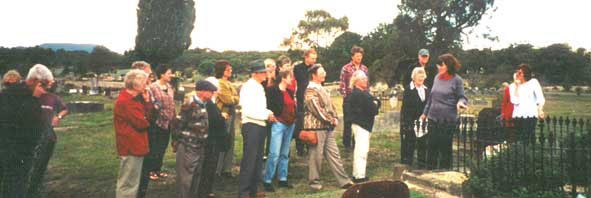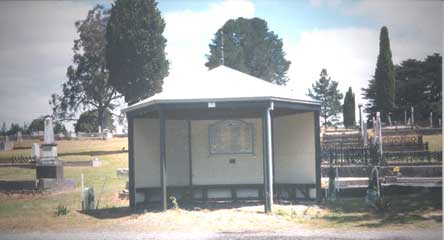Buninyong Cemetery
OLD BURIAL GROUND
There were a number of burials at Buninyong's old burying ground since the beginnings of the township in the early 1840s. The burial ground was located just outside the town, in Learmonth St, beyond the Post Office. An information board marks its location.
It is very difficult, if not impossible, to know who
was buried in the old area, because there are no records and no
headstones survived. Civil registration of births, deaths and
marriages was not introduced in Victoria until July 1853. Before
that date we rely on Church records of baptisms, marriages and
deaths, and many names do not appear in these records.
There is evidence that the local Aboriginal people practised
tree burial, leaving their dead in a particular orientation in
burnt-out trees.
The first death recorded in the district was that of
Terence McManus, a shepherd working for the Learmonth Brothers,
who was speared by Aborigines near Sebastopol in April 1838. In
November 1846 Edward Martin, a servant of John Veitch, was
murdered at the Buninyong Inn, and Euphemia Innes, wife of
George, King of the Splitters, died in childbirth on the 1st of
January 1847. On 1st February Corporal William Harvey of the
Buninyong mounted police, was mortally wounded and attended by
Dr. Power as he died.
PRESENT CEMETERY
 A map sketched by Assistant Surveyor Smythe in 1849,
when he was making his preliminary survey of the township of
Buninyong, shows the present cemetery designated as "General
Cemetery" on the map, and divided up into four denominational
sections. So it seems possible that from 1850 the cemetery began
to be used.
A map sketched by Assistant Surveyor Smythe in 1849,
when he was making his preliminary survey of the township of
Buninyong, shows the present cemetery designated as "General
Cemetery" on the map, and divided up into four denominational
sections. So it seems possible that from 1850 the cemetery began
to be used.
On 9th December 1852, Dr. Richard Power, the district's
doctor since 1842, died unexpectedly at the age of 50. He was a
great loss to the district. His gravestone is the earliest in
the Buninyong Cemetery, in the Anglican section, cared for by
the Buninyong and District Historical Society. Another pioneer
was Thomas Hiscock, the discoverer of gold, who died in 1855.
His headstone is in the Presbyterian section of the cemetery.
The discovery of gold in the Buninyong district in 1855-6
brought great numbers of diggers and their families to the
district, and many deaths by accident or disease. Many deaths
related to child bearing, with women and their babies risking
death in the unhygienic conditions of the tent towns. The need
for a formal, large cemetery for the district dates from these
rushes.
It would appear from entries in the Government Gazette
that the cemetery officially began in 1855.

PLAN OF CEMETERY

This reduced plan of the Buninyong cemetery is basically
the same as the original survey. It is a Christian tradition
that graves face Jerusalem in the East so the denominational
sections are laid out on a North-South axis.
The majority of the first white settlers to this
district were of Scottish descent and the Presbyterian Church
has a large section located on the Eastern boundary. The
remaining denominations share the remaining area, with the
Chinese being allocated the North-West corner. As the pattern of
immigration changed, the Episcopalians (United Church of England
and Ireland, or Church of England) and Wesleyans (Methodist)
were allocated additional sections to the West of the Roman
Catholic section.
In 1995 a rotunda was constructed in the grounds of the cemetery, a project of the Buninyong and Mt. Helen Lions Club, and a plan of the cemetery is displayed in the Rotunda and the Buninyong Information Centre, 408 Warrenheip St, Buninyong, which is open Tues-Sun from 10:00am to 3:00pm.
A booklet about the cemetery is also on sale. (Click on the link for details)